SILK IN CHINA
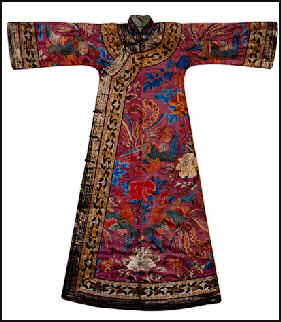
Qing-era silk dress The Chinese character for happiness is a combination of the symbols for white, silk, and tree. In ancient China silk was used as currency and a reward, and the imperial court established silk factories to weave ceremonial garments and gifts to foreign dignitaries.
More than ten million farmers in China raise silk and nearly half a million people are employed in silk-fabric production. In 1982, China exported 36,000 tons of silk, primarily to markets in the United States, Japan and Europe. [Source: Nina Hyde, National Geographic, January 1984]
China produces 80 percent of the world's tussad (wild silk) and 50 percent of the world's supply of silk yarn. Italy and France produced better finished products than China. And the most prized silk of all is Chinese silk yarn made into fabrics at Italian mills.
A third of China's raw silk, brocade and satin comes from the Zhejiang Province, the "Land of Silk." Describing the city of Suzhou, near Zhejiang in the Jiangsu Province, in 1276, Marco Polo wrote: "They have vast quantities of raw silk, and manufacture it, not only for their own consumption, all of them being clothed in dresses of silk, but also for other markets.
See Separate Article SILK, SILK WORMS, THEIR HISTORY AND PRODUCTION factsanddetails.com ; Articles on AGRICULTURE IN CHINA factsanddetails.com ; SILK ROAD factsanddetails.com
Good Websites and Sources: History of Silk silk-road.com ; Wikipedia article on silk Wikipedia ; Wikipedia article on Silkworms Wikipedia ; Wormspit wormspit.com ; Raising Silkworms silkwormshop.com Silk Making in Shanghai galenfrysinger.com ; About Silkworms ; senature.com senature.com
Silk
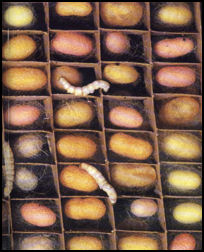
Silkworm cocoonsSilk is a wonderfully strong, light, soft, and sensuous fabric produced from cocoons of the Bombyx caterpillar, or silkworm Of all the fabrics, silk is regarded as the finest and most beautiful. It has a wonderful sheen — the result of triangle-shaped fibers that reflect light like prisms and layers of protein that build up to a pearly sheen — and can be dyed a host of wonderful colors. The former fashion editor of the Washington Post Nina Hyde wrote, “Designers revel in its feel, its look, even its smell." [Source: Nina Hyde, National Geographic, January 1984, ╟]]
Silk can be used for all sorts of things. In addition to being woven into fabric, it has been made into cold cream in China, beauty powder and parachutes in the United States, teeth braces in Italy and fishing nets around the world. Bicycle racers say that tires made with silk give them a smoother ride and better traction. Skiers like it because it wicks away moisture and scientist say silk is stronger than steel. In Japan silk artists are revered as national treasures. In India corpses are covered with silk shrouds as a sign of respect. Frugal Ben Franklin splurged on a silk kite for his famous electricity experiments and the first French atomic bomb was dropped from balloon partly of silk.╟
Silk production is largely automated and done in factories but the raising of silk worms to make silk is still very a “cottage industry” done primarily at people’s homes. In some cases government provides anyone who is willing to raise silkworms with 20 kilograms of very small silkworm grubs, which are placed in special boxes in special rooms and fed mulberry leaves gathered from trees near the homes of the farmers raising them.
Early History of Silk
According to a Chinese legend, silk was discovered in 2460 B.C. by the 14-year-old Chinese Empress Xi Ling Shi who lived in a palace with a garden with many mulberry trees. One day she took a cocoon from one of the trees and accidentally dropped it hot water and found she could unwind the shimmering thread from pliable cocoon. For hundreds of years after that only the Chinese royal family was allowed to wear silk. Xi Ling Shi is now honored as the goddess of silk.
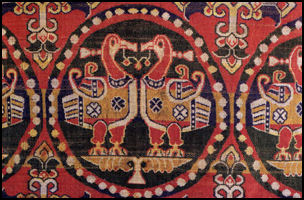
8th century Sogdian silk
The oldest concrete evidence silk weaving are impressions found on a bronze urn dated to 1330 B.C. The provincial museum in Hangzhou houses silk threads and embroidery knots that may be 4,500 years old. In 1982 brickyard workers stumbled across a ancient tomb from 300 B.C. with remarkably well preserved silk quilts and gowns. ╟
The secret of making silk remained in China for 2,000 years. Imperial law decreed death by torture to those who disclosed it. No one is sure when the secret first seeped out of China, but it is known to have reached Japan by way of Korea by the A.D. forth century and said to have been brought there by four Chinese girls. It is also said that silk was brought to India by a Chinese princess who hid eggs and mulberry seeds in the lining of her head dress.
Sericulture and Silk Craftsmanship Recognized by UNESCO
Sericulture and silk craftsmanship of China was inscribed on the UNESCO Intangible Cultural Heritage List in 2009. According to UNESCO: Sericulture and silk craftsmanship of China, based in Zhejiang and Jiangsu Provinces near Shanghai and Chengdu in Sichuan Province, have an ancient history. Traditionally an important role for women in the economy of rural regions, silk-making encompasses planting mulberry, raising silkworms, unreeling silk, making thread, and designing and weaving fabric. [Source: UNESCO]
It has been handed down within families and through apprenticeship, with techniques often spreading within local groups. The life cycle of the silkworm was seen as representing the life, death and rebirth of human beings. In the ponds that dot the villages, silkworm waste is fed to fishes, while mud from the ponds fertilizes the mulberry trees, and the leaves in turn feed the silkworms. Near the beginning of the lunar year, silkworm farmers invite artisans into their homes to perform the story of the Goddess of the Silkworm, to ward off evil and ensure a bountiful harvest.
Every April, female silkworm farmers adorn themselves with colourful flowers made of silk or paper and make harvest offerings as part of the Silkworm Flower festival. Silk touches the lives of rural Chinese in more material ways, too, in the form of the silk clothes, quilts, umbrellas, fans and flowers that punctuate everyday life.
Sericulture
The process or raising silkworms and unwinding their cocoons is called sericulture. Silkworms have to be carefully taken care of: they need to be fed regularly and maintained in a carefully controlled environment. It is a labor intensive industry, generally requiring lots of people willing to work for low wages.
Making silk begins when a female silkworm lays her eggs. In China, the eggs are often produced in special institutions regulated by the government to make sure the eggs are healthy. Workers speed up the hatching process by soaking the eggs in chemicals. About a week after the eggs are laid, silkworm grubs emerge. They are around a quarter of an inch in length and the width of a hair. They squirm into huge flat baskets, filled with mulberry leaves and are placed on shelves.
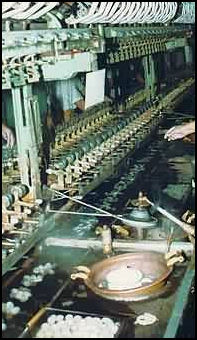
Silk spinning
The silkworms spend their 25- to 28-day long lives in baskets, or trays, munching on mulberry leaves. Even though the baskets are open the silkworms do not try to escape. Silkworms are extraordinary eating machines. They can eat and breath at the same time, taking in oxygen from nine holes on the sides of their body, and make eating sounds compared with fizzing Alka-Seltzer. They are especially hungry right before they begin making their cocoons. In some cases they are fed ten times a day and their body weight increases 10,000 times in their short lives.
The main raw material other than the silkworms themselves are the leaves from mulberry trees. In the past, mulberry trees were raised on hilly areas while lowlands were devoted to rice growing, and peasants had to spend a lot of time picking leaves off the trees. These days the leaves are produced on trees grown on plantations very far from where the silkworms are raised and trucked in to wear the silkworms are raised.
A hundred kilograms of mulberry leaves yields 25 silkworm cocoons. The caterpillars used to make the kimono devoured over 135 pounds of mulberry leaves. The 8,000 worms supply silk for ten blouses, consume approximately 350 pounds of mulberry leaves. The leaves from plantation-grown mulberry trees are plucked, chopped and prepared for the silkworms. In Japan, they are mixed with beans and agar into a concoction that looks like sweet bean paste. After the trees are stripped they are pruned and sprayed for next year's crop.
Silk Production
A typical three- to four-centimeter-long cocoon produces a 1- to 1.5-kilometer-long filament. Raw silk needs to be cleaned and twisted into heavier yarns before it is ready for cloth making. This process is called throwing. It is highly mechanized and is similar to spinning cotton. An average factory can produce about six tons of raw silk a month.
The production of silk in a processing mill usually begins when the silk cocoons are placed in a hot-air chambers to kill the caterpillar pupa and dry out the cocoons in such a way that the unbroken silk threads remains undamaged. If they silkworms were allowed to live they would damage the silk threads when they broke out of the cocoon. The cocoons are soaked in hot water to soften them up and get rid of the natural glues. Silkworm cocoon are sometimes yellow and pink; these colors are boiled out during processing. Women often work all day with the hot cloudy water, which is too hot for most of us to touch.
To make silk yarn, the nearly invisible strands from five to eight cocoons plucked from the hot water and plied together and placed into the eye of a reeling machine, which pulls the thread from the cocoons, twists them together into a single yarn that is 800 to 1,200 meters long and is wound on spools. Natural glues left on the strands bind the yarn together. At factories in China, women stand all day in front of reeling machines. If a cocoon stops bobbing, the person operating the reeling machines knows a strand has broken or run out and the end of another cocoon is unraveled and put in its place.
During a second reeling, the silk is measured into specific lengths. The silk yarn is then graded for shipment. The process the silk goes through afterwards often depends on the quality of the silk. Weighted silk is colored with dye and dipped in a solution of metallic salts that add weigh and give it a sheen. Spun silk is made from the floss and other wasted filaments of the silk process. These fibers are carded and spun into yarn using methods similar to those used to make wool.
Wild silk comes most from two kinds of moths: the Antherea mylita of India and the Antherea pernyi of China. The strands from the cocoons made these moths are coarser and more difficult to unravel. They are often made into spun silk.
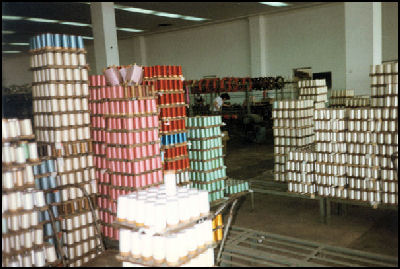
Silk thread
Silk Production in China
After the silk is harvested at Dongshan People's Commune in eastern China the cocoons are carried by boat in table-size baskets to government purchasing stations. The commune is paid, depending on quality and weight, about three dollars a kilogram (2.2 pounds) for the crop.
At a factory in Dadong women stand all day in front of reeling machines washing the silk cocoons and loosening the silk thread with hot cloudy water, which is too hot for most of us to touch. Silk workers near Hotan often starch silk on the loom by spitting water on it.
Women who unwind silk cocoons often plop the silkworms in boiling water and munch on them. “They seem to eat off and on all day long since they work rapidly for long hours at a stretch, and the cooked morsels are constantly before them. One gets a pleasant odor of food being cooked, when passing through a reeling factory.”
Silk Products
Chinese doctors replace diseased arteries with silk prostheses. In the 1950s, Dr. Feng Youxian read about grafts in vascular surgery in the United States. "We had no synthetics," he said, "What we had was silk." The material for his first operation was clipped from his shirt and sewn into a tube by his wife.
After the silk has been removed, the shrimp-size silkworm pupae are delivered to restaurants where they are stir fried in garlic, ginger, pepper, soy sauce and oil. Silkworm pupae are high in protein and said to be good for high blood pressure. When the Chinese have finished sucking out the meat they spit the shells on the table and floor.
Silkworms are being pushed as a food source as they are high in protein and need less feed than cattle and other mammals and can be raised in smaller spaces. Already silk worm pupae are widely eaten in Korea. Japanese researchers have made silkworm cookies and steamed buns by mixing silkworm pupae with brown rice and soybeans.
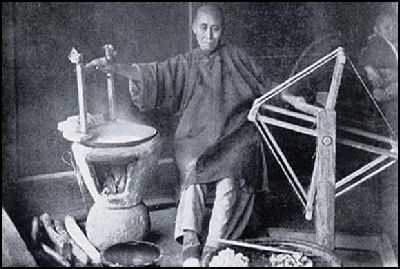
Silkworm waste, or frass, is used for fish food and fertilizer, and dead pupae are pressed for oil which is made into soaps and cosmetics. Resting one's head on a pillowcase filled with frass is said to ease the pain of rheumatism and frass tea is supposed to cure a number of ailments.
Image Sources: University of Washington; Silk Road Foundation; Beifan.com ; Nolls China website http://www.paulnoll.com/China/index.html; Columbia University
Text Sources: New York Times, Washington Post, Los Angeles Times, Times of London, National Geographic, The New Yorker, Time, Newsweek, Reuters, AP, Lonely Planet Guides, Compton’s Encyclopedia and various books and other publications.
Last updated October 2021
